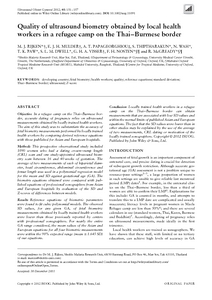Rijken, MJ; Mulder, EJ; Papageorghiou, AT; Thiptharakun, S; Wah, N; Paw, TK; Dwell, SL; Visser, GH; Nosten, FH; McGready, R
(2012)
Quality of ultrasound biometry obtained by local health workers in a refugee camp on the Thai-Burmese border.
Ultrasound in Obstetrics & Gynecology, 40 (2).
151 - 157.
ISSN 0960-7692
https://doi.org/10.1002/uog.11091
SGUL Authors: Papageorghiou, Aris
![[img]](https://openaccess.sgul.ac.uk/101670/1.hassmallThumbnailVersion/uog0040-0151.pdf)  Preview |
|
["document_typename_application/pdf; charset=binary" not defined]
Published Version
Download (374kB)
| Preview
|
Abstract
Objective:
In a refugee camp on the Thai–Burmese border, accurate dating of pregnancy relies on ultrasound measurements obtained by locally trained health workers. The aim of this study was to substantiate the accuracy of fetal biometry measurements performed by locally trained health workers by comparing derived reference equations with those published for Asian and European hospitals.
Methods:
This prospective observational study included 1090 women who had a dating crown–rump length (CRL) scan and one study-appointed ultrasound biometry scan between 16 and 40 weeks of gestation. The average of two measurements of each of biparietal diameter, head circumference, abdominal circumference and femur length was used in a polynomial regression model for the mean and SD against gestational age (GA). The biometry equations obtained were compared with published equations of professional sonographers from Asian and European hospitals by evaluation of the SD and Z-scores of differences between models.
Results:
Reference equations of biometric parameters were found to fit cubic polynomial models. The observed SD values, for any given GA, of fetal biometric measurements obtained by locally trained health workers were lower than those previously reported by centers with professional sonographers. For nearly the entire GA range considered, the mean values of the Asian and European equations for all four biometric measurements were within the 90% expected range (mean ± 1.645 SD) of our equations.
Conclusion:
Locally trained health workers in a refugee camp on the Thai–Burmese border can obtain measurements that are associated with low SD values and within the normal limits of published Asian and European equations. The fact that the SD values were lower than in other studies may be explained by the use of the average of two measurements, CRL dating or motivation of the locally trained sonographers
| Item Type: |
Article
|
| Additional Information: |
Copyright © 2012 ISUOG. Published by John Wiley & Sons, Ltd.
Re-use of this article is permitted in accordance with the Creative Commons Deed, Attribution 2.5, which does not permit commercial exploitation. |
| Keywords: |
Adult, Biometry, Crown-Rump Length, Female, Fetus, Health Personnel, Humans, Myanmar, Pregnancy, Prospective Studies, Refugees, Thailand, Ultrasonography, Prenatal, Young Adult |
| SGUL Research Institute / Research Centre: |
Academic Structure > Institute of Medical & Biomedical Education (IMBE)
Academic Structure > Institute of Medical & Biomedical Education (IMBE) > Centre for Clinical Education (INMECE ) |
| Journal or Publication Title: |
Ultrasound in Obstetrics & Gynecology |
| ISSN: |
0960-7692 |
| Dates: |
| Date | Event |
|---|
| 30 July 2012 | Published |
|
| PubMed ID: |
22262286 |
| Web of Science ID: |
22262286 |
  |
Download EPMC Full text (PDF)
|
 |
Download EPMC Full text (HTML)
|
 |
Go to PubMed abstract |
| URI: |
https://openaccess.sgul.ac.uk/id/eprint/101670 |
| Publisher's version: |
https://doi.org/10.1002/uog.11091 |
Statistics
Item downloaded times since 06 Oct 2014.
Actions (login required)
 |
Edit Item |




